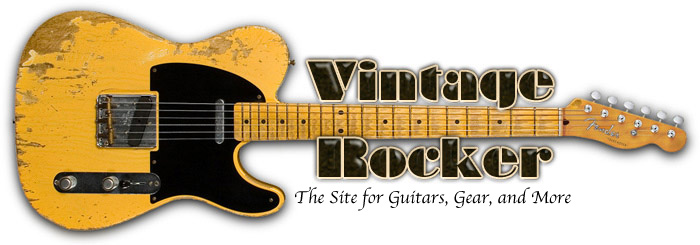
FENDER TELECASTER
|
The first Fender solidbody model, the Esquire, lasted (in name only) from April 1950 to October 1950. This model name was replaced by the "Broadcaster", which lasted (in name only) from the October 1950 to January 1951. The majority of Broadcasters are dated November 1950. All Broadcasters have truss rods, where all 1950 Esquires have no truss rod. In 1937 Gretsch had trademarked the name "BroadKaster" for a line of drums. After advertising the Broadcaster in music trade papers in February1951, Gretsch took notice and sent Fender a telegram asking them to change their name. Therefore Fender was forced to drop the name Broadcaster. Starting in February 1951, Fender cut the word "Broadcaster" off of their headstock decals. These models (February 1951 to summer 1951) are known as "NoCasters". Starting in the summer of 1951, Fender adopted the name "Telecaster" for this model, and started using new decals after all the old clipped decals were used.
Note that the above dates are accurate. But be aware that Fender was a month or two ahead in making body parts. Therefore, you can find NoCasters with December 1950 neck dates, even though they didn't clip the decals and do final assembly till February 1951 (decal application was the last assembly step were always applied over the finish). Making the body and neck (and dating them) was the first assembly step, and hence these dates can be a couple months before the instrument was finalized and shipped. All Telecasters basically have the same features: single cutaway slab body, 2 chrome knobs, 3 position toggle switch, 3 paired adjustable bridge saddles, strings anchor thru body (except in late 1958 to 1959). October 1950 Broadcaster : Ash body with Butterscotch Blond finish. Maple one piece neck, all with truss rods. Round button string tree (1st month models don't have one). Flat pole pickup in treble position. Chrome covered pickup in neck position. Black fiber pickguard, clear coated with lacquer. Serial number on bridge plate. Round switch tip. Steel bridge saddles till November 1950, then brass with flat bottoms. Body date in neck pocket. All screws have slot heads. February 1951 "NoCaster" : Fender decal with "Broadcaster" cut off. Summer 1951 Telecaster : After all cut "NoCaster" decals used, "Telecaster" decals appear. Gradual use of phillips head screws replaces slot head screws (this change was not complete till 1953). Early 1954 Telecaster : Serial number on neck plate. Late 1954 Telecaster : White Blond finish replaces butterscotch finish. White single layer vinyl pickguard replaces black pickguard. Bridge saddles change from brass to small steel smooth saddles. Mid 1955 Telecaster : Staggered pole pickup in treble position. "Top Hat" style switch tip replaces round tip. Sunburst finish available. Body date moved from neck pocket to under lead pickup (late 1955). Mid 1956 Telecaster : String tree changes from round button to "butterfly" clip. 1958 Telecaster : Bridge saddles change from smooth to threaded saddles. Strings anchor at bridge ("top loading") instead of going thru the body (late 1958). Mid 1959 Telecaster : Slab Rosewood fingerboard. Single layer thick white pickguard (custom color Teles used 3 layer celluloid mint green pickguard). Tele Custom introduced with 3 layer celluloid mint green pickguard. Starting in 1959, Fender introduced a new model, the Telecaster Custom. It was the same as a standard Tele except it came in three color sunburst, and the body is bound. 1960 Telecaster : Strings anchor thru the body again. Mid 1962 Telecaster : Veneer Rosewood fingerboard. 1963 Telecaster : 3 layer celluloid mint green pickguard on all models. Fall 1964 Telecaster : Pearl fingerboard dots replace "clay" dots. White plastic three layer pickguard. Late 1965 Telecaster : Gold Fender decal thicker than previous "Spaghetti" logo. Maple fingerboard available as an option (black dots). 1968 Telecaster : Black Fender decal. "F" style tuning gears replaces Kluson-Deluxe gears. Polyester thick finish replaces nitrocellulose lacquer. String ferrules on back now stick out, no longer flush. Pink paisley and blue floral finishes available 1968 & 1969 only. Tele Thinline was introduced. The Telecaster Thinline, much like Gibson's 335, has a solid center with hollow "wings" and a single "F" hole. Although there were several deviants of the original Tele Thinline, the only collectable model is the one with standard Tele-style single coil pickups. This variant was made from 1968 to 1971 and said "Fender Telecaster" only on the peghead (as per regular solidbody Telecasters), the truss rod adjusted at the butt-end of the neck, and had a pearloid pickguard going from the neck pickup to the tone control. In 1971, Fender changed the model to use Humbucking pickups, a "bullet" truss rod (adjusts at peghead), and the peghead decal now says "Fender Telecaster Thinline". The original Telecaster Thinline was reissued by Fender of Japan in the early 1990's. The Rosewood Telecaster, introduced in 1969, had a neck and body made from solid rosewood. This guitar was reissued by Fender of Japan in the late 1980's and is a very close reproduction. |

